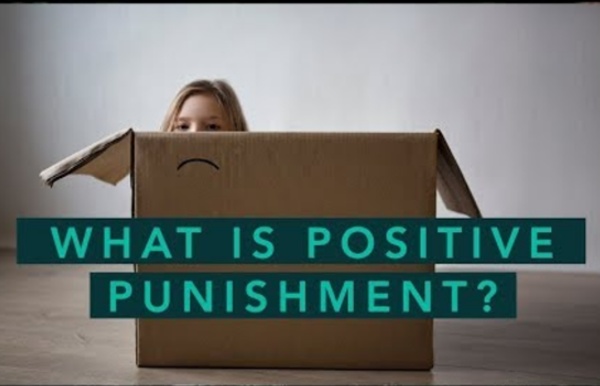



http://www.youtube.com/watch?v=fReFfnYxedg
Related: How Reinforcement And Punishment Can Help Parents In Influencing The Behavior Of Teenage Children • Operant Conditioning: How does it influences behaviours of teenagers • Reinforcement and Punishment in Parenting: Teenagers • Reinforcement vs Punishment: Disciplining teenage children • shxhrvlReinforcement vs. Punishment: What They Are & 12 Examples "Reinforcement is anything that increases the likelihood that a person will exhibit the same behavior again in the future," says licensed psychologist Nicole Beurkens, Ph.D., CNS. "You are aiming to increase a desired behavior such as speaking politely, doing chores, playing nicely with siblings, and so on." And chances are you're likely doing this already in some capacity: You praise your kid for tidying up after themselves, you compliment them after getting good grades in school, you take them out for a treat after hitting a milestone or doing well in an extracurricular. As Pressman tells us, it's simply "giving kids attention for a certain behavior." However, reinforcement can backfire, if done incorrectly.
Punishing a Child Is Effective If Done Correctly TORONTO — While recently published parenting books have preached the effectiveness of positive parenting and “no drama” discipline, psychologists presenting at the American Psychological Association’s 123rd Annual Convention said don’t put timeout in timeout yet. “Parental discipline and positive parenting techniques are often polarized in popular parenting resources and in parenting research conclusions,” presenter and researcher Robert Larzelere, PhD, of Oklahoma State University, said at a symposium. “But scientifically supported parenting interventions for young defiant children have found that timeouts and other types of assertive tactics can work if they’re administered correctly.”
In a Nutshell Positive punishment is a popular concept in parenting. We'll explain what it is and how you can implement it with six examples. Parenting isn't always a walk in the park, and determining the best way to address your child's inevitable poor behavior can be a tricky line to walk. Techniques like positive punishment and negative reinforcement (two parenting "buzzwords" that you've probably heard a lot already) are just two of the ways parents and child care providers can try to correct a child's behavioral issues.
How to Properly Use Reinforcement and Punishment - North Shore Pediatric Therapy Reinforcement and punishment are common terms that most people have heard of and use on a daily basis, whether they realize it or not. Although the concepts seem easy to understand and implement, it can be easy to confuse the basic principles and/or implement them incorrectly. In order to understand the difference between reinforcement and punishment, it is important to understand the definitions of both terms. Reinforcement Article 3a.2: Negative Reinforcement and Operant Conditioning Did you know that parents could train their children to act defiant? “Who in their right minds would do that?” you may wonder. Well, many of us actually do. Find out how a lot of parents unknowingly train their children in rebellion using negative reinforcement.
Positive vs Negative Reinforcement: Which Is More Effective? Table of Content: 1. What is Reinforcement? 2. What are the different types of Reinforcement? 3. Why you should stop yelling at your kids The use of spanking to discipline children has been in decline for 50 years. But yelling? Almost everybody still yells at their kids sometimes, even the parents who know it doesn’t work. Yelling may be the most widespread parental stupidity around today. Punishments vs. Consequences: Teach Your Teen the Difference When I work with parents of teenagers, our conversations inevitably turn toward discipline. “How do get my teen to follow the rules?” “My teen won’t clean up after himself. Reinforcement vs. Punishment: Changing BehaviorBehavioral Health Works Being a parent has been known as the best thing ever BUT also the most challenging endeavor you will encounter in your lifetime. Parents strive to raise a healthy and happy child that will one day grow up as a full-fledged mature and independent adult. But to successfully accomplish this goal, a parent must set forth structure or rules throughout their childhood to help them understand and be realigned when their behavior needs to be modified.
Article 3a.1: Using Positive Reinforcement to Improve Behavior When your child misbehaves, rewards might be the last thing on your mind. But, positive reinforcement can be one of the most effective behavior modification techniques.1 You can use positive reinforcement to encourage prosocial behaviors, like sharing or following directions. And, you can use it to prevent misbehavior, like hitting and rule violations. Positive reinforcement can also be an effective way to encourage and motivate your child to be responsible, do their chores, get along with their siblings, or complete their homework assignments without arguing. How Positive Reinforcement Works
Reinforcement vs. Punishment: Changing Behavior Being a parent has been known as the best thing ever BUT also the most challenging endeavor you will encounter in your lifetime. Parents strive to raise a healthy and happy child that will one day grow up as a full-fledged mature and independent adult. But to successfully accomplish this goal, a parent must set forth structure or rules throughout their childhood to help them understand and be realigned when their behavior needs to be modified. When a parent recognizes the need to change a behavior, they will likely end up using either reinforcement, punishment, or a mixture of both.
Parents' Use of Physical Punishment Increases Violent Behavior Among Youth Violent behavior is one of the leading causes of mortality among youth. Research has revealed numerous predictors of violent behavior among youth, many of which relate to various forms of violence exposure (e.g., media violence, bullying, neighborhood violence, corporal punishment, etc.). In this study, researchers examined the relationship between young adolescents’ involvement in and attitudes toward violence, parental use of physical punishment, and parental expectations of violence use (both perceived and stated) among youth. The study was conducted with the participation of 134 parents and their children (aged 10-15 years), focusing on both urban and suburban populations.